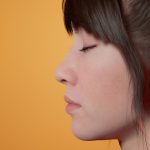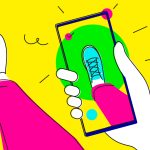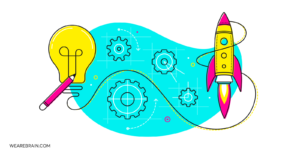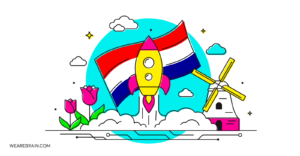AI image generators: Future of creative content?

We have become accustomed to leveraging smart technologies to automate many of our daily tasks. From scheduling and bookings to information searching and smart home setups, there is an algorithm dedicated to simplifying our lives. But we are entering an era where robots are evolving from assistants to artistic digital creators.
AI-powered tools have been programmed to generate creative content for some time, from art generated by GPT3 to literature to music. However, these tools have followed specific rules and criteria to develop one-of-a-kind content. With the release of the latest AI image generator tools, machines are able to create any image conceivable in seconds.
Let’s take a look at AI image generators and how they work.
How do AI image generators work?
Simply put, AI image generators can create original, realistic images from text input in a natural language. They can combine styles, concepts, and attributes to create extraordinarily artistic and relevant images based on the written prompt. By analysing the internet’s worth of images and their written descriptions, AI image generators learn what objects are and how they relate to each other.
AI image generators use two neural networks. The first neural network creates an image while the second judges how close to the real thing the image is, based on real-life examples from the internet. Once scoring the image for accuracy is complete, the data is sent back to the original AI system. That system then learns from the feedback and sends back an altered image for further scoring until the AI-generated image matches the control/template image.
Yes we know, it sounds confusing. If you have some technical knowledge and wish to get your hands dirty, here’s a great tutorial on how GPT and diffusion models work.
For example, Cosmopolitan magazine has released the cover for its latest issue that has no trace of human intervention both behind or in front of the camera. Using the innovative new AI-powered image generator DALL-E 2, the Cosmo team typed in a specific input to get the cover image they were after.
“A wide angle shot from below of a female astronaut with an athletic female body walking with swagger on Mars in an infinite universe, synthwave, digital art” was the final prompt that generated the image now being used as the official cover.
Popular AI image generators
Here is a list of the most popular AI image generators:
DALL-E
Off the back of its predecessor DALL-E, OpenAI’s second iteration DALL-E 2 is perhaps the most popular AI image generator. Apart from being able to generate unique images, DALL-E 2 can also be used to create design products and illustrations.
Generating a DALL-E 2 image does not require any artistic or IT knowledge, meaning both professionals and amateurs can successfully create original images thanks to its simple interface. Most notably, DALL-E 2 offers a paintbrush tool which allows users to add further details to the image, such as shadows and highlights.
Interestingly, DALL-E 2 is currently unavailable to the wider public. Only a select group of artists, content creators and AI developers have been given access to the tool for predetermined time periods. There is even a waiting list for limited access to it.
Deep Dream Generator
Google’s Deep Dream Generator is able to create incredibly realistic images using a neural network trained with millions of images. All you have to do is upload a control/reference image and Deep Dream will generate a new one based on the original.
Deep Dream is catered more toward formulating artistic images thanks to its use of various painting styles from a particular era (Renaissance, Gothic, Cubism, etc.). Furthermore, you can choose to add a final filter to the image, Thin Style, Deep Style, or Deep Dream which have their style that can transform an image.
Anonymizer
Anonymizer is a tool that generates a different picture for users who want to protect their identities from facial recognition software. Trained on thousands of photos, the generator feeds images into generative adversarial networks (GANs) that create new ones. The images are created by two neural networks (generator and discriminator) that work off each other to generate samples and examine whether they look real enough before presenting the final product.
DeepAI
DeepAI is making AI image generation accessible to anyone through its open-source software that offers many different tools to create realistic results. With DeepAI, users are able to generate unlimited images with each one being unique. The tool’s highly customisable functionality allows users to make adjustments to the amount of detail, textures, colours, styles, and more.
DeepAI also caters to artists and designers by allowing them to type an illustration that can immediately be generated into a resolution-independent vector image.
Problems with text-to-image generation
There have been reports that this new technology is also generating some discriminatory results. Despite AI technologies being responsible for the most advanced processes on the planet, we still have a far way to go to stamp out prejudice fringe cases.
After all, these technologies are still beholden to human input. They gather data from the internet which is home to both the best and worst aspects of humanity, so the data source is compromised in certain aspects. But because these AI generator tools allow anyone to type in anything into the input field, it opens up the gateway for racists, bigots, misogynists, and all other colourful variations of undesirable human traits to use and abuse these tools.
At this stage, the creators of these advanced AI image generators have not yet focused on trying to eliminate these options from the input field. We’ve written about AI’s algorithm inequality and biases and we are still waiting to see actionable change. But the datasets gathered to make these tools perform are taken largely from the internet, a place that showcases the good and bad qualities of human nature. So, it is up to us, the users, to play our part in stamping out the vile and toxic fringe perspectives that are only hindering society’s advancement.
David Roman
Working Machines
An executive’s guide to AI and Intelligent Automation. Working Machines takes a look at how the renewed vigour for the development of Artificial Intelligence and Intelligent Automation technology has begun to change how businesses operate.







